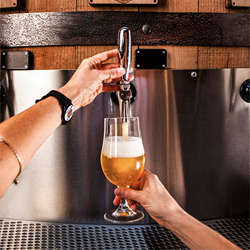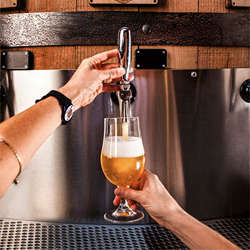
After years of owning and operating restaurants, Carl Bruggemeier has built a successful restaurant and hotel advisory business by adhering to a single principle: avoid waste where possible. In that context, Bruggemeier, founder and CEO of CZH Hospitality Group, was intrigued when he heard about the iKeg from SteadyServ Technologies, a sensor that attaches to beer kegs and links to an app that provides information about supply levels and integrates with an inventory management system.
When he first learned the sensor could tell him "what’s happening with every keg I’ve tapped in my restaurant [by utilizing] the cloud, I was utterly fascinated. As an owner/adviser/operator, I’d have access to the system everywhere,’’ he says. "I did not have to be standing next to the POS system in a restaurant to get a report on what’s happening. All I have to do is open my iPhone."
Bruggemeier had the iKeg system installed about nine months ago at two restaurants he is working with in Indiana. The system costs $500, plus $3 every time a keg is depleted. "That’s less than the cheapest pint of beer I sell," he notes.
The software-as-a-service (SaaS) inventory and order management system is one of the latest entries on the market tapping into the Internet of Things (IoT) phenomenon, a "network of networks of uniquely identifiable endpoints (or ‘things’) that communicate without human interaction using IP connectivity," according to technology market intelligence company IDC. That firm projects the worldwide market for IoT solutions for homes, cars, and all aspects of daily life will reach $7.1 trillion in 2020, up from $1.9 trillion in 2013.
SteadyServ Technologies chairman and CEO Steve Hershberger says the idea for a keg sensor came after he and a friend started a brewery in Indianapolis. It was through that experience they learned that "everybody in the beer industry guesses about their supply chain."
A bartender or other employee will "shake the kegs and then they’ll guess how full they think they feel, and they’ll only shake a few because there may be 60 kegs in the cooler and they may weigh 170 pounds, so you shake the ones closest to you and then you guess about the others," Hershberger explains. That guess is not necessarily predicated on what beer people want to buy, what’s in the cooler, or what may be available from the distributor, he adds.
"We realized there’s a huge industry having some prolific problems, and our job became solving the problem." The answer was iKeg, which collects information on how much beer is left in a keg, as well as the type and style of the beer; when it was delivered; when it was tapped; its age, and when the keg is likely to run out. That information is sent to SteadyServ’s cloud-based software, where it is combined with information about the bar to help the retailer determine how much stock they have, as well as the date of their next delivery from the distributor, previous order information, past consumption trends, and even beer consumption trends in the area, among other types of information.
The iKeg system uses machine-to-machine (M2M) communication technologies for inventory and order management accuracy, Hershberger says.
David Christman, senior director of State & Industry Affairs at the National Beer Wholesalers Association, calls SteadyServ a "neat idea" that will benefit restaurants and bars. Echoing Hershberger, he says, "Other than the old-fashioned try to lift [a keg] … there hasn’t really been a scientific measure of how much is left in there. This is a way to know this keg is about to be empty and another needs to be reordered."
Christman says he knows of only one similar technology: iPourIt. Customers coming into bars equipped with iPourIt have their identification and credit card swiped, and then are given a unique RFID wristband; they then can pour their own beer, with a sensor in each keg’s tap handle reading their unique wristband ID, and a valve connected to the tap measuring the amount of beer they pour, allowing the business to charge by the ounce for "100% of every ounce in a keg," according to the company.
These types of sensors are "going to be a great information and data source beyond when a keg is going to be empty," says Christman. "It’s going to help [retailers] see what their consumer desires the most and help them make decisions going forward."
In the two restaurants where he had SteadyServ installed, Bruggemeier says beer waste has already been cut by 15% to 20%. Additionally, he says they have probably save three to four hours per week of management time in the ordering and inventory process, because that has been automated.
Bruggemeier is now looking at "tap analysis and trending analysis and finding which taps are most productive and learning how to price based on what’s pouring extremely well and perhaps modifying price based on demand," he says. In the long run, he adds, the application will result in "terribly significant ROI in both restaurants."
Esther Shein is a freelance technology and business writer based in the Boston area.




Join the Discussion (0)
Become a Member or Sign In to Post a Comment